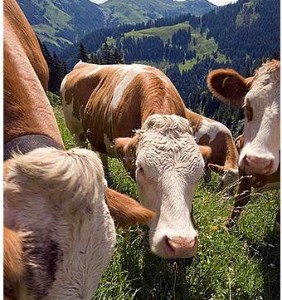 [5]By Oregon State University Extension Service [6],
[5]By Oregon State University Extension Service [6],
PORTLAND, Ore. – Children can tell the difference between grass- and grain-fed beef, but when it comes to preference, they’re evenly split, according to taste tests that Oregon State University conducted at two grade schools in Portland.
Portland Public Schools asked OSU to conduct the surveys as part of its effort to serve more locally produced food. The district had been considering serving hamburger patties made from local grass-fed cattle instead of the grain-fed beef that it now serves and whose origin is unknown to the district.
But before purchasing the costlier grass-fed beef, school officials needed to know if students would even like it and could detect a difference, said Gitta Grether-Sweeney, an assistant director for the school district’s nutrition services department. So they consulted someone who understands taste buds: Ann Colonna, the manager of the Sensory and Consumer Program at OSU’s Food Innovation Center. Located in northwest Portland, the research center helps develop, test and market edible products made from Northwest commodities.
This fall Colonna asked 96 students in the school named Clark K-8 @ Binnsmead in southeast Portland to taste three similar-looking hamburger patties and identify the one that was different. In some cases, two came from grass-fed beef and the third was from grain-fed cattle. In other instances, it was the other way around. Seventy-three of the students correctly identified the patty that was different.
With a difference detected, Colonna moved to the next level: preference. She asked 91 students at Abernethy Elementary in southeast Portland to taste two hamburger patties made from the two types of beef served in the prior taste test.
The students were not told that one was made from grass-fed cattle and the other was from grain-fed herds. Sitting at tables in the cafeteria, each student received a quarter of a patty in a wheat bun served on a paper plate with the number 372, denoting the grain-fed beef, and a similar-looking serving on another plate with the number 681, the code for the grass-fed one.
After eyeballing, eating, smelling and sometimes even licking the patties, the students then turned to their paper ballots and circled the number of the patty they preferred. Forty-five students preferred the grass-fed while 46 liked the grain-fed best.
“For now, since there was not a strong preference for the grass-fed patty, and it is more expensive, we will not be able to afford to serve the grass-fed patty on a regular basis,” Grether-Sweeney said.
The grain-fed beef the district serves costs $17.11 per case (with 140 patties per case) and the particular brand of grass-fed beef it tested costs $44.85 a case (with 75 patties per case), she said.
She added that Portland Public Schools would still dish up the grass-fed beef in all its cafeterias on Jan. 8 as part of its “Local Lunches” program. Under the program, once a month the district serves a meal made entirely of products from Oregon, Washington or northern California.
After the Abernethy students turned in their ballots, Cory Schreiber asked the students to describe why they liked the patties they chose. Schreiber, the founder of Portland’s Wildwood Restaurant, manages a program called Farm to School for the Oregon Department of Agriculture that aims to put more locally produced food in schools.
“I liked 681 because it had a tiny bit of salt,” a boy said.
One girl said she preferred the grain-fed beef because “it tasted kind of like bacon and the other one was too salty and too dry.”
The grass-fed beef the students tasted in the surveys came from Portland-based SP Provisions, which processes a brand of beef called Cascade Natural Beef. It’s made from Angus steers in Oregon and Washington that are raised on grass, but for the last four months of their lives are fed grain and corn to fatten them up, said Jim Register, the general manager of the company.
The Portland school district doesn’t know where the beef it serves is raised because it comes from the U.S. Department of Agriculture’s entitlement program, which buys beef from all over the United States.
In the taste tests, which were funded by the USDA, both types of patties were cooked in an oven. Because the grain-fed one is shipped precooked, that meant it was actually cooked twice. The patties looked similar except that the grain-fed one was a little darker because of the double cooking. The burgers contained 80 percent beef and 20 percent fat. The grain-fed patty contained hydrolyzed corn protein, dextrose, salt, flavorings, sodium phosphates and caramel color. Because the grass-fed one didn’t use any seasonings, Schreiber sprinkled salt on it for a more equal comparison with the salted grain-fed one.
By: Tiffany Woods
Source: Ann Colonna, Cory Schreiber, Gitta Grether-Sweeney